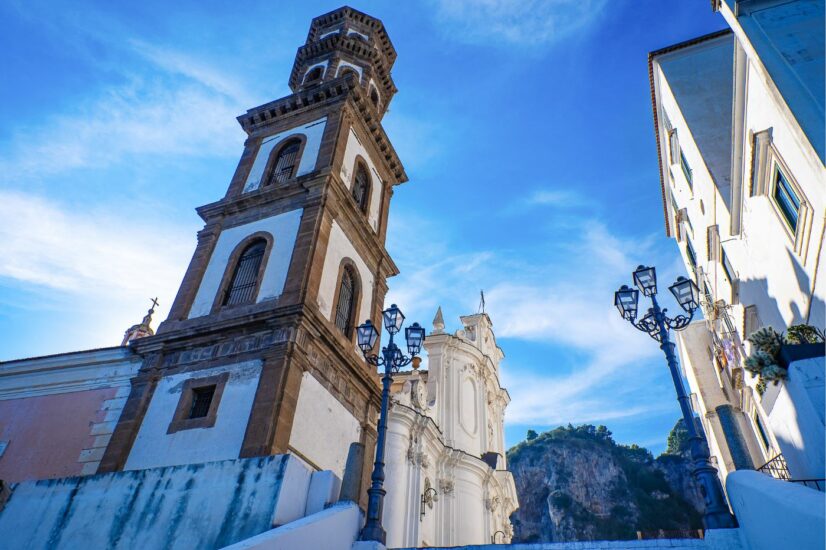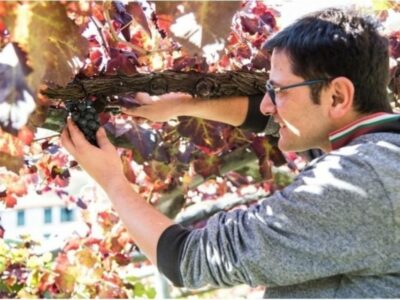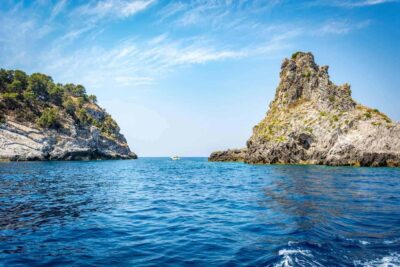When night falls and the street lamps are lit, the small houses of the village of Atrani, leaning against each other, and its narrow stairways, which intertwine in a kind of labyrinth, are charged with suggestion: the picturesque village, in the morning full of light, becomes like a delightful nativity scene overlooking the sea.
The sensation of being inside a nativity scene becomes a tangible reality during the Christmas period, when the small town is adorned, here and there, with coloured lights artfully placed under the arches bordering the small beach: at that point, one cannot help but smile in ecstasy, feeling even a little bit like a child.
But Atrani’s charm, which we also discuss in this full article, does not end there.
The smallest town on the Amalfi Coast, in fact, holds within its 0.1206 km² of surface area two truly precious treasures that are definitely worth a visit: the Church of San Salvatore De Birecto and the Colleggiata di Santa Maria Maddalena.
We discuss them in detail in the following paragraphs, where we will provide you with all the information you need to organise your visit and a few curiosities to stimulate your desire to discover these unique monuments even more.
Table of Contents
The Collegiate Church of Santa Maria Maddalena: the Church dedicated to the Patron Saint of Atrani

If you have already visited Atrani, or if you will visit it in the future, one of the most remarkable things you will notice when you arrive in its small centre is the yellow and green tiled dome that stands out from above and dominates the village: this is the dome of the Church of Santa Maria Maddalena, the patron saint of Atrani, celebrated every year on 22 July.
The Collegiate Church of Santa Maria Maddalena is a true architectural jewel, rooted in a millennial history. Erected in 1274 on the remains of an ancient watchtower, the church was dedicated to the patron saint as a sign of gratitude for having freed the Atranese community from foreign occupation. The cult of Saint Mary Magdalene, however, had already been widespread in the area since the 12th century, testifying to a deep bond between the population and the figure of the penitent saint.
Over the centuries, the church has been restored and enlarged numerous times, assuming the Baroque appearance that characterises it today and that makes it unique on the Amalfi Coast: if you visit it, remember that you are visiting a little gem, representing the only Rococo-style monument on the Amalfi Coast. You will immediately notice it, from the soft lines and the relief stuccoes that characterise the façade.
The three-nave interior houses precious frescoes and sculptures, among which is Andrea Sabatini’s ‘The Incredulity of Thomas’. Also of special interest is the Chapel of the Sacrament, rich in decorations and sacred furnishings.
A recent discovery has further increased the artistic and historical heritage of the Collegiate Church: in fact, the sacred relics of St. Mary Magdalene, including bone fragments, hair and a piece of the Cross of Jesus, were found.
In addition to the relics, historical documents of inestimable value were also recovered, including an unpublished musical score by Leonardo Leo, entitled ‘Dalla Morte alla Vita di Maria Maddalena’ (‘From Death to the Life of Mary Magdalene’): a discovery that has opened up new perspectives for the study of 18th-century musical production and has contributed to making the figure of Leonardo Leo, one of the most important Italian composers of his time, even better known.
📅 When to visit the Collegiata di Santa Maria Maddalena
The Church of Santa Maria Maddalena is only visited during religious services. However, during the summer period, it is easier to find it open to the public, as a group of volunteers work to make it visitable.
📣 Curiosities
On 22 July, solemn celebrations are held in honour of St Mary Magdalene, with the customary procession and a fireworks spectacle at the end of the festival.
A typical traditional dish is ‘sarchiapone’: a recipe that takes a long time to prepare, but the result is truly delicious. It is, in fact, a long pumpkin, which is fried, stuffed with meat and cheese and then baked in the oven.
The Church of San Salvatore De’ Birecto

Overlooking Atrani’s delightful little square, the Church of San Salatore De’ Birecto offers us the chance to step back a few centuries, unravelling some interesting historical anecdotes on the events of the ancient Amalfi Republic.
You must know that it was in this very church that the investiture of the doges was held: ‘Birecto’ was in fact the ducal cap, used for the investiture ceremony.
Over the centuries, the building has changed profoundly, but careful restoration is bringing back to its original beauty. The three-nave interior, with its cross-vaulted ceiling, conceals unexpected surprises: recent excavations have revealed two pointed arches and a semi-open room dating back to the 13th century, radically altering our understanding of the original structure.
The incomplete façade features an elegant two-storey superstructure with a clock and a belfry, while the bronze door by Pantaleone di Viarecta is a masterpiece of medieval art, with its 24 panels depicting biblical scenes and figures of saints.
Inside, you can admire a valuable 12th century pluteus, decorated with peacocks and other fantastic animals, testifying to the high artistic level reached by the city at that time. historical and artistic importance.
📅 When to visit the Church of San Salvatore De’ Birecto
The Church is open in the morning from 10.30 to 13.00 and in the afternoon from 15.00 to 18.00.
However, we advise you to check in advance if you are planning a visit to Atrani. You can try using the Church’s Facebook page for more up-to-date and accurate information.












